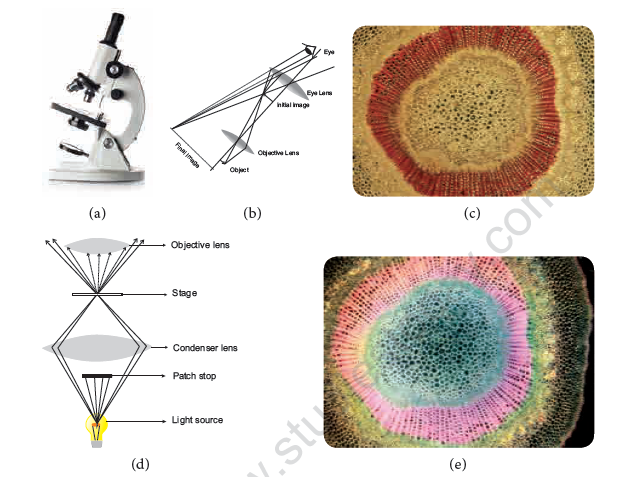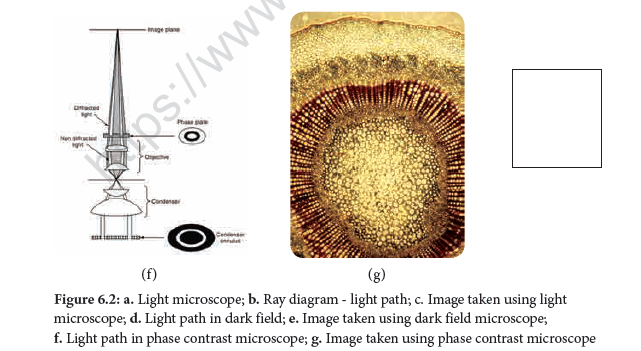Learning Objectives:-
The learner will be able to,
• Describe the cell and contributions of early scientist towards its discovery
• Appreciate the use of light and electron microscopes for better understanding of the cell
• Understand the ideas of cell theory and the different concepts associated with it
• Distinguish the significant characters of various groups of life forms
• Recognize the basic structure of cell and differentiate the cells of animals, plants, bacteria and viruses
• Explain the structure and functions of cell organelles including nucleus
• Recognize the structure of chromosome and its types
• Describe the flagellar structure, types and movements
• Get acquainted with the cytological techniques
Chapter Outline
6.1. Discovery
6.2. Microscopy
6.3. Cell theory
6.4. Cell types
6.5. Plant cell and Animal cell
6.6. Cell organelles
6.7. Nucleus
6.8. Flagella
6.9. Cytological techniques
The word ‘cell’ comes from the Latin word ‘Celle” which means ‘a small compartment’. The word cell was first used by Robert Hooke (1662) therefore the term ‘cell’ is as old as 300 years.
6.1. Discovery
Aristotle (384-322BC), was the one who first recognised that animals and plants consists of organised structural units but unable to explain what it was. In 1660’s Robert Hooke observed something which looks like ‘honeycomb with a great little boxes’ which was later called as ‘cell’ from the cork tissue in 1665. He compiled his work as Micrographia. Later, Antonie von Leeuwenhoek observed unicellular particles which he named as ‘animacules’. Robert Brown (1831-39) described the spherical body in the plant cells as nucleus. H. J. Dutrochet (1824),a French scientist, was the first to give idea on cell theory. Later, Matthias Schleiden (German Botanist) and Theodor Schwann (German Zoologist) (1833) outlined the basic features of the cell theory. Rudolf Virchow (1858) explained the cell theory by adding a feature stating that all living cells arise from pre-existing living cells by ‘cell division’.

6.2. Microscopy
Microscope is an inevitable instrument in studying the cell and subcellular structures. It offers scope in studying

microscopic organisms therefore it is named as microscope (mikros – small; skipein – to see) in Greek terminology. Compound microscope was invented by Z. Jansen.
Microscope works on the lens system which basically relies on properties of light and lens such as reflection, magnification and numerical aperture. The common light microscope which has many lenses are called as compound microscope. The microscope transmits visible light from sources to eye or camera through sample, where interaction takes place.
6.2.1 Bright field Microscope
Bright field microscope is routinely used microscope in studying various aspects of cells. It allows light to pass directly through specimen and shows a well distinguished image from different portions of the specimen depending upon the contrast from absorption of visible light. The contrast can be increased by staining the specimen with reagent that reacts with cells and tissue components of the object.
The light rays are focused by condenser on to the specimen on a microslide placed upon the adjustable platform called as stage. The light comes from the Compact Flourescent Lamp (CFL) or Light Emitting Diode (LED) light system. Then it passes through two lens systems namely objective lens (closer to the object) and the eye piece (closer to eye). There are four objective lenses (5X, 10X, 45X and 100X) which can be rotated and fixed at certain point to get required magnification. It works on the principle of numerical aperture value and its own resolving power.
The first magnification of the microscope is done by the objective lens which is called primary magnification and it is real, inverted image. The second magnification of the microscope is obtained through eye piece lens called as secondary magnification and it is virtual and inverted image (Figure 6.2 a, b and c).
6.2.2 Dark Field Microscope
The dark field microscope was discovered by Z. Sigmondy (1905). Here the field will be dark but object will be glistening so the appearance will be bright. A special effect in an ordinary microscope is brought about by means of a special component called ‘Patch Stop Carrier’. It is fixed in metal ring of the condenser component. Patch stop is a small glass device which has a dark patch at centre of the disc leaving a small area along the margin through which the light passes. The light passing through the margin will travel oblique like a hollow cone and strikes the object in the periphery, therefore the specimen appears glistening in a dark background. (Figure 6.2 d and e).
6.2.3 Phase contrast microscope
This was invented by Zernike (1935). It is a modification of light microscope with all its basic principle. The objects observed by increasing the contrast by bringing about change in amplitude of the light waves. The contrast can be increased by introducing the ‘Phase Plate’ in the condenser lens. Phase plate is a circular component with circular annular etching.



